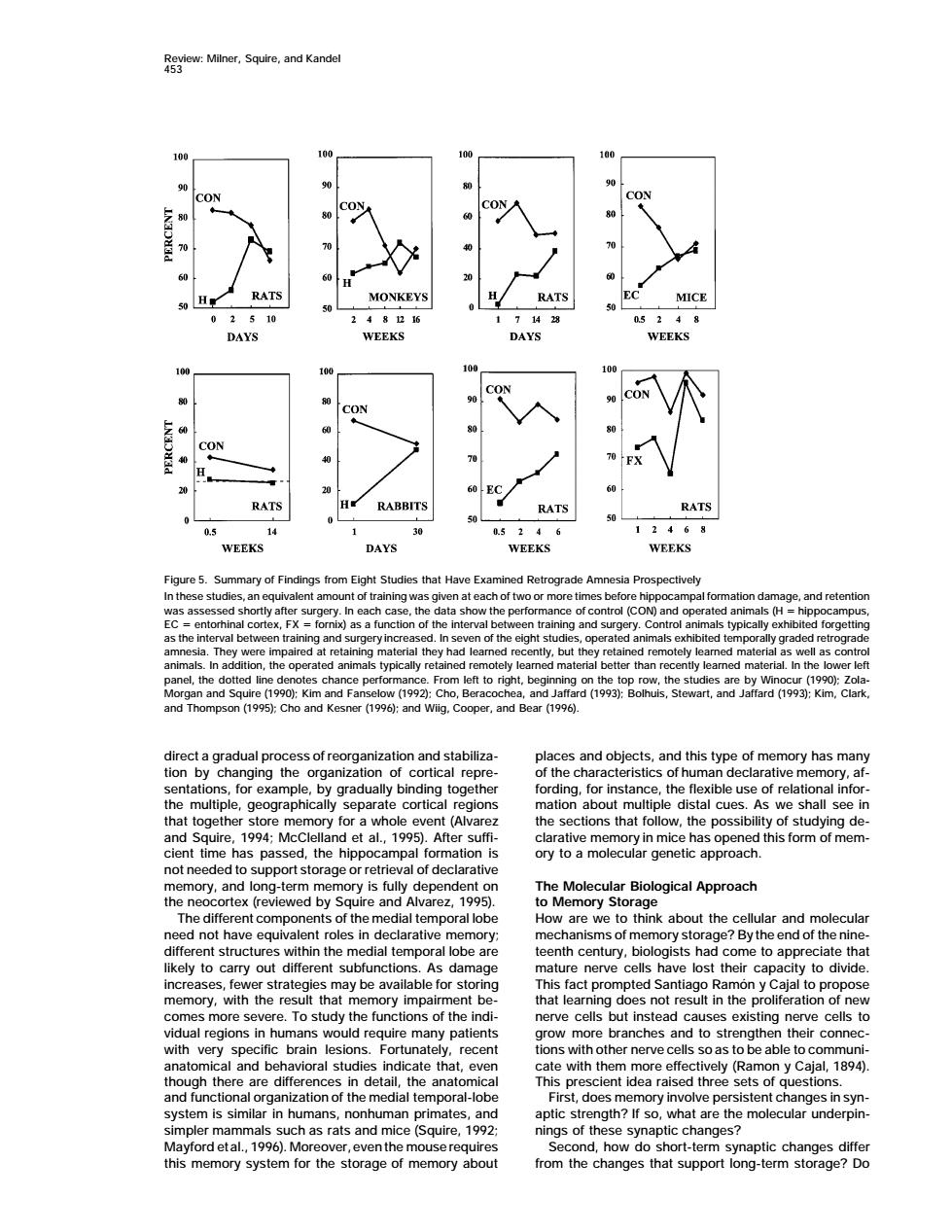正在加载图片...

RAT ONKEYS ATS WEEKS DAYS RATS RATS pe nd fa w1992 96 and and this typ of me nging the tion of cortica repre f the ristics of hun declarativ the ograph ion ng. es.As we shall see 1994 et al 1995.Ane suff mem in mice edthis form dod to ory to a mol cular genetic approach DeMpeccBeogealAproach compone of the r ial te emporal lob different structures vithin ial temp eenth century.biologists ha e to appreciate tha S.fry ou be available for on y o Caial ory. cels butnste in th s to d re d to their conne ate tha l.1894 and fun of the medial temp This t.does m simp mal h as rats and mic 1992 of these sy aptic ch eta for the of m thd,how hatReview: Milner, Squire, and Kandel 453 Figure 5. Summary of Findings from Eight Studies that Have Examined Retrograde Amnesia Prospectively In these studies, an equivalent amount of training was given at each of two or more times before hippocampal formation damage, and retention was assessed shortly after surgery. In each case, the data show the performance of control (CON) and operated animals (H 5 hippocampus, EC 5 entorhinal cortex, FX 5 fornix) as a function of the interval between training and surgery. Control animals typically exhibited forgetting as the interval between training and surgery increased. In seven of the eight studies, operated animals exhibited temporally graded retrograde amnesia. They were impaired at retaining material they had learned recently, but they retained remotely learned material as well as control animals. In addition, the operated animals typically retained remotely learned material better than recently learned material. In the lower left panel, the dotted line denotes chance performance. From left to right, beginning on the top row, the studies are by Winocur (1990); ZolaMorgan and Squire (1990); Kim and Fanselow (1992); Cho, Beracochea, and Jaffard (1993); Bolhuis, Stewart, and Jaffard (1993); Kim, Clark, and Thompson (1995); Cho and Kesner (1996); and Wiig, Cooper, and Bear (1996). direct a gradual process of reorganization and stabiliza- places and objects, and this type of memory has many tion by changing the organization of cortical repre- of the characteristics of human declarative memory, afsentations, for example, by gradually binding together fording, for instance, the flexible use of relational inforthe multiple, geographically separate cortical regions mation about multiple distal cues. As we shall see in that together store memory for a whole event (Alvarez the sections that follow, the possibility of studying deand Squire, 1994; McClelland et al., 1995). After suffi- clarative memory in mice has opened this form of memcient time has passed, the hippocampal formation is ory to a molecular genetic approach. not needed to support storage or retrieval of declarative memory, and long-term memory is fully dependent on The Molecular Biological Approach the neocortex (reviewed by Squire and Alvarez, 1995). to Memory Storage The different components of the medial temporal lobe How are we to think about the cellular and molecular need not have equivalent roles in declarative memory; mechanisms of memory storage? Bythe end of the ninedifferent structures within the medial temporal lobe are teenth century, biologists had come to appreciate that likely to carry out different subfunctions. As damage mature nerve cells have lost their capacity to divide. increases, fewer strategies may be available for storing This fact prompted Santiago Ramo´ n y Cajal to propose memory, with the result that memory impairment be- that learning does not result in the proliferation of new comes more severe. To study the functions of the indi- nerve cells but instead causes existing nerve cells to vidual regions in humans would require many patients grow more branches and to strengthen their connecwith very specific brain lesions. Fortunately, recent tions with other nerve cells so as to be able to communianatomical and behavioral studies indicate that, even cate with them more effectively (Ramon y Cajal, 1894). though there are differences in detail, the anatomical This prescient idea raised three sets of questions. and functional organization of the medial temporal-lobe First, does memory involve persistent changes in synsystem is similar in humans, nonhuman primates, and aptic strength? If so, what are the molecular underpinsimpler mammals such as rats and mice (Squire, 1992; nings of these synaptic changes? Mayford etal., 1996). Moreover, even the mouse requires Second, how do short-term synaptic changes differ this memory system for the storage of memory about from the changes that support long-term storage? Do